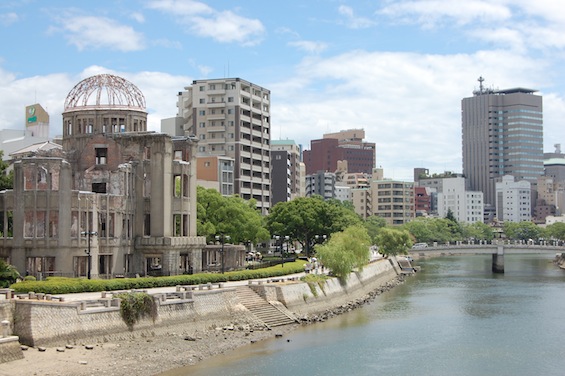Hiroshima today – with the memorial dome on the left of the photo.
It was the 65th anniversary of the dropping of the world’s first atomic bomb on Hiroshima on 6 August, and I have just returned from a troubling visit to the city.
Here’s why it was troubling. The focus of the commemoration was on the terrible suffering of the people of Hiroshima as a result of the attack – and that, I guess, is as it should be. But the whole atmosphere of the event – not to say the tone and layout of the hugely popular museum in the ‘Peace Park’ close to the epicentre of the explosion – was utterly condemnatory. The dropping of the bomb on Hiroshima is not exactly described as ‘a war crime’ in the official Japanese literature, but a visit to the Hiroshima museum certainly gave me the impression that this was what the Japanese authorities want people to think it was. This sense that the Japanese were ultimately ‘victims’ of the war was something which a Japanese academic explicitly expressed to me some years ago. ‘There were two horrendous crimes of WW2,’ he said. ‘The Holocaust and Hiroshima’.
Really? Is that how we should remember Hiroshima?
The problem is that by focusing on the horror of the attack on Hiroshima we are in danger of omitting the crucial context of the attack – and only that context allows us to judge what happened properly. Here is, for example, how I would lay out the structure of the museum in Hiroshima. The exhibition ought to start with the story of the Japanese aggression in China, beginning with the attack on Manchuria in 1931 and then the full scale conflict on mainland China which began in 1937. The behaviour of the Imperial Japanese Army in China ought to be laid bare explicitly – the story of the rape of Nanking and the history of the millions and millions of Chinese who were the victims of systematic torture and murder.
The museum should then describe the decision of the Japanese government to formalize an alliance with Nazi Germany and Fascist Italy by joining the ‘Pact of Steel’ in 1940 in an attempt to benefit from the destablization of French colonies in South East Asia caused by Hitler’s victory over the French. Visitors should then learn how the Japanese authorities ordered their forces to move into Indo-China (today’s Vietnam) until, in the summer of 1941 the Americans had finally had enough of Japanese aggression in Asia and announced that they would no longer sell oil to the Japanese. The result was still more Japanese aggression, beginning with Pearl Harbour, swiftly followed by the seizure of Hong Kong (and the rape of British nurses) and the conquest of much of Burma, Malaysia and Indonesia.
The museum should then detail how the British and Americans and their Allies then began the long and costly fight back against the Japanese Imperial Army, in the knowledge that their own POWs were being appallingly treated in Japanese captivity. The Japanese soldiers defended themselves fanatically in places like Iwo Jima and Saipan. And, as result, the Allies feared that an invasion of the Japanese home islands would result in horrendous casualties. Not least because most of Japan looks like this:

The near-impenetrable forests of Japan
The soldiers of the Japanese Imperial Army had already demonstrated at Okinawa in the spring of 1945 that they were prepared to allow the Americans to land on the beaches, and would then take them on in the mountains and jungles. If such a strategy had been implemented on the home islands of Japan in the wake of an Allied invasion, it would have resulted in one of the most bloody battles in the history of the world.
And so the decision was taken to drop nuclear bombs on Japan in order to force the Japanese government to surrender. (For my last WW2 project I made a special study of the decision making process around the dropping of the bomb and emerged convinced that the primary reason the bombs were dropped was to end the war and save Allied lives, rather than the desire to impress Stalin with the new weapon, as a few people still seem to believe).
In this telling of the history, the horror of Hiroshima still remains, of course. But it is contextualised. Dropping the bombs on Hiroshima and, three days later, on Nagasaki meant that Japan surrendered and an invasion of the home islands was rendered unnecessary.
Yes, the citizens of Hiroshima and Nagasaki were victims of WW2. But primarily they were victims of the appalling aggressive desires of their own government, military and Emperor.
Now that’s not a story you will find told in Hiroshima museum.
 Twitter
Twitter







The Japanese may feel that Hiroshima was a war crime because the Americans admit they only attacked the city so they could asses the full power and destructive capabilities of the bomb. The city was of no strategic importance and was left mainly untouched before the bomb was dropped, the Americans however needed the Japanese to see the full destructive capabilities of the weapon in hope that it would lead them to surrender or face total annihilation. Thankfully they were right and countless hundreds of thousands of lives both allied and Japanese were saved
Thank you for setting things right. When you compare the efforts made by the Germans to atone for the crimes of the Third Reich and the way in which the Japanese have been trying to pose as victims you realize how easily the latter got away with what they did. It is almost as if Himmler et al. had remained in power in Germany and been able to rewrite history. (However we should not underestimate the responsibility of Gen. MacArthur–and more generally the American political establishment–in the whitewashing of war crimes to bolster Japan in its fight against the Red Peril. In many ways the same is true of Austria which for geopolitical reasons was proclaimed a victim of the Third Reich thus exonerating the Austrians of all responsibility.)
Yes the bomb was horrible but the Japanese elites and the Emperor brought it upon their own people. THEY are responsible and THEY committed this heinous sin.